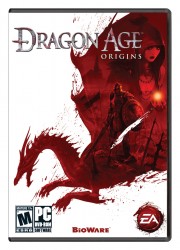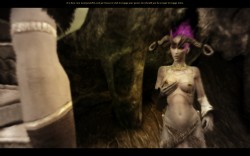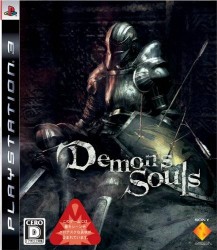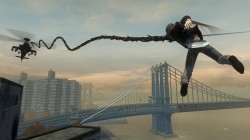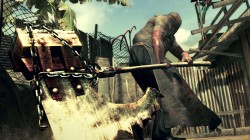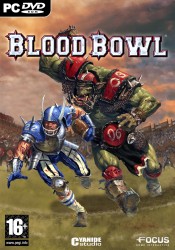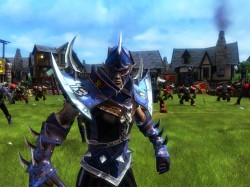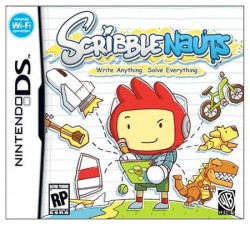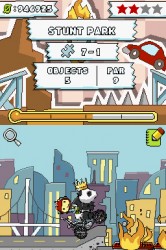Compared to last year it was quite a struggle to even come up with ten games from this year to include on a top ten list. It seems that a huge amount of titles got pushed back to 2010 and those blockbuster titles that did come out in 2009 were nearly uniformly overrated or just plain shite (I’m looking at you here Halo:ODST, Brutal Legend and Assassins Creed II).
Oh well I suppose that it does mean that the first few months of 2010 have a mental amount of potentially awesome games being released. Another interesting (ha) fact became apparent when compiling this list, nearly every game on it is a sequel, whether direct or spiritual. In fact I think Demon Souls and Scribblenauts are the only two games that are genuinely new.
Before getting into the meat of this I’m going to go on something of a tangent. A tangent not unfamiliar to frequent readers. I really like fighting games, ever since I first warily entered Potter’s arcade at the tender age of thirteen and got beasted by some bastard using Blanka. I spent large portions of my youth playing fighting games in arcades and then when they made the transition to home consoles I played them on that as well. But as the years went by competition dwindled and while I enjoy fighting games they lose a lot when played “solo”. So at this point I still really like fighting games but dont play them as much as I would like. However Ive again strayed off topic, after their hey-day in the nineties the decline of the arcade and the dominance of the home console rapidly eroded the fighting game markets. In the english speaking markets we see barely a handful of fighting games released each year, usually just sequels to proven licences. Japan does a bit better (and still has a strong enough arcade scene though the Wii may be changing that) but still not great. However that all seems to have turned around in 2008 which saw an unprecedented number of fighting games released on both the console and arcade fronts. A trend which continued in 2009. I have to say its nice to see and has helped re-invigorate my flagging interest in the genre.
So as I mentioned above my first real experience with fighting games was with the arcade version of Street Fighter II and as I also mentioned I got fucking done. Of course my recently jumpstarted hormones weren’t going to take that lying down. Unfortunately for my hormones the regulars in Potters operated under some kind of fucking omerta when it came to telling you how to play the game. No internet back in those days, no siree.
Luckily the burgeoning street fighter craze led to the publication of myriad strategy guides, all obtained post swimming lesson from easons in newry following some maternal wrangling. In tandem with this I started hanging around with a chap in my class called Frank, who was not only a fan of street fighter II, but as a “townie” possessed both the esoteric knowledge of how and where to play. So I kissed Potters goodbye and made for the (metaphorically) greener pastures of the Island. Every day after school I’d trudge down Castletown road with Frank, stop of briefly in his house and then head on to the arcade. Needless to say such devoted practice yielded results and I was soon a dab hand at Ryu (the greatest of the world warriors) and one golden twenty pence piece would guarantee hours of play as challenger after challenger propped his coin against the screen.
My love and frequent play of the game continued up through Championship and Turbo edition. I toyed with Sagat for a while but soon returned to Ryu. But as time went by my friends interests drifted and I ended up going to the arcades by myself. Which may not have been the greatest plan in the world as evidenced by the evening I failed to provide some knacker a smoke and got chased by a gang of youths from mid clanbrassil street to out past the dump. No mobile phones then, just useless public phone boxes and the irritating jangle of pockets full of change. Anyhow that sort of soured me on the whole arcade thing but not on Streetfighter, no sir. But with only console play and basically no competition other than the occasionally press ganged younger sibling, my love of Streetfighter lay dormant for several years.
Until in first year of college a friend of mine turned me on to anime, in particular the anime available from Cassidy’s video store. Now I’d always been a fan of cartoons and comics and thanks to a) coming in wankered one Friday night and b) channel 4’s late night anime broadcasts I wasn’t entirely ignorant of the phenomenon. But it was John who turned me onto it in a mainstream way. Anyhow, to get back on target, my next encounter with the Street Fighter franchise was when I chanced across the Street Fighter II animated movie. Even over a decade later it remains one of my favourite anime movies, from the amazing opening bout between Ryu and Sagat to Chun Li’s shower scene, from the grunge rock soundtrack to what lies beyond your fist it is a wonderful admixture of fan service and action movie. It also looked awesome at the time of release.
This reignited my interest for Street Fighter in a big way, but unfortunately I had no outlet for this interest. My Snes and Megadrive had long since been destroyed or misplaced and Ed only had one fucking game for his PSX! So with no outlet it returned to dormancy. I had no Saturn to play the Alpha series and while I had a Dreamcast I loathed the various Street Fighter III incarnations for straying too far from what I saw as the quintessential incarnation of street fighter, Street Fighter II.
So we return to dormancy once more, emerging again for the uncut DVD release of the film in ’06 (Go,go Chun Li shower scene!) and for Udon’s lovely looking if glacially released Street Fighter comics.
It wasn’t until late in the lifecycle of the Xbox that I stumbled across both Street Fighter Anniversary Collection and hardcore online fighting communities such as Shoryuken.com. The level of dedication exhibited was inspiring, even if most of the individual members of said communities would only be useful as kindling. But as is the way of such things, actually in all honesty, with everything, I seem incapable of motivating myself with an external stimulus.
But this time we returned, not to dormancy, but to fitful sleep, roused sporadically for weeks of practice or for testing out new arcade paraphernalia purchased for other things. So with all this in mind I think it’s fair to say that I was pretty excited when Street Fighter IV was announced, this excitement grew as more details emerged, a return to the Street Fighter II timeline and roster, classic 2d fighting with saucy 3d character models (go Rumble Fish), etc. And best of all an excitement and longing for the game in the wider gaming public, which promised competition.
Everything I heard made me more excited about it, I had the collectors edition ordered as soon as it was released, this was followed shortly by one of the Madcatz Tournament edition FightSticks and one of their six button joypads (the Ryu one of course). All three set to be delivered to my sisters suitors house via first class mail in order to insure the quickest possible delivery.
I booked time of work (nothing spectacular in that, I’d book time of work for eating a sandwich if I could) and prevailed upon my long suffering mother to pick up the game and it’s accessories from my sister as soon as they arrived. As usual my longing to play a game was stymied by both the Ps3’s system update and the games install procedure. But as I watched the awesome intro unfold I knew I wasn’t going to be disappointed and Im happy to say that I was right.
The game looked, played and sounded great. An instantly accessible roster of well known characters made it feel like coming home. Of course if you’ve trudged through the paragraphs above you will know that my bias is huge. But in an attempt at objectivity (and because I can’t find that many ways to say “Its awesome”) I will point out that the game and to some extent the handling of it’s release, aren’t entirely perfect.
Firstly in terms of enjoyment having to slog through arcade mode and beat that cheap fucker Seth just to unlock short cinematics of (disappointingly) varying quality was not much fun. Secondly I would have liked to see a more thorough practice mode, something akin to the excellent one included in Virtua Fighter V. As an addendum to that, don’t include unexplained combos in challenge mode which rely on esoteric links and timing. Just tell the player everything, this juvenile secret keeping creates an unneeded barrier to entry (and is disappointingly also present in the community and culture of the genre as a whole). Third, while I’m happy to support the game and am a big fan of DLC the DLC put out for this game did feel a tad exploitive. Fourth, I would have liked to see more balance in the roster.
Still none of these problems really detract that much from the game and should all hopefully be addressed in Super Street Fighter IV which should be out in early April.
I’ve been playing computer games for a long time, starting with a flat top game of Pacman in a pub somewhere, quickly moving on to Chuckie Egg on the MSX. From there I graduated up through the Sinclair Spectrum to the Amstrad CPC. Console gaming was provided by my sisters much commandeered Megadrive and later my own SNES. I received my first PC for Christmas of 1990 or 91 (with a seemingly limitless 70mb hardrive – quite the step up from having to save my homemade text based sex adventures to cassette tape).
As an avid fan of fantasy literature the rpg has always been a firm favourite of mine, I remember renting many obscure import titles from the megadrive rental place on Dublin street (across from where the garage is, can’t remember the name of it though I want to say Oasis). The first game I really remember playing in giant sleep deprived sessions was some offshoot of the Might and Magic series, followed by some isometric game who’s name escapes me (off I go to wikipedia to read through the entire list of released megadrive games) and finally the AD&D based Knights of the Eternal Sun. Well some Internet searching later it turns out that the Might and Magic game is most likely Might and Magic II: Gates to Another World and the isometric one is Rings of Power (second ever game from Naughty Dog) I forgot how much I fucking loved that game. It’s also the first game where I remember killing defenceless npc’s just for xp. Thanks to Niamh and Patricks Christmas present (a megadrive) and some eBay action I am once more the proud owner of rings of power.
On the Pc it was Ultima 7 (still one of the most expansive RPGs I’ve ever played) and then (and this is more or less the point) there was Baldurs Gate. Baldurs Gate was huge and I played it a lot, a lot a lot. In many ways Baldurs Gate was the pinnacle of western CRPG’s of that type and once it was done it seemed that that particular brand of rpg died out . Well apart from the sequel, the Ice Wind Dale games and Planescape:Torment, none of which I played or at least didn’t play till years later.
But then over a decade late along comes Dragon Age, a clear spiritual successor to Baldurs Gate which improves upon it in every conceivable way. This is the kind of western CRPG I want to play, not the weird fps/action rpg hybrid exemplified by stuff like Oblivion. This is the kind of classic crpg gaming I enjoyed updated to take into account advancements in both technology and audience desire and sophistication.
The games looks, sounds and plays great (though the gore is weirdly overdone). It’s story, while not super original, is well plotted and engaging and the unique origins and choices presented really draw the player into the narrative. The Npc’s and the world at large are also well realised and generally engaging (could have done with Loghain being a tad less obvious in his evilness, “what’s that? a character in the role of a vizier with goth makeup and voiced by Simon Templeman? He seems trustworthy”)
Like most Bioware game the real appeal lies with the story and the characters as opposed to the game system itself. Quite possibly because Bioware’s actual game system is often flawed in major or minor ways. For a change I actually really liked the game system used in DA:O. It’s a robust system that can be played as anything from a minimal interaction “run and gun” action game or an impeccably micromanaged tactical exercise where each action is carefully planned and manually implemented. Personally I went with the middle ground, generally leaving NPC actions to be taken care of by the games in-depth and customisable scripting system. From what I’ve read online the game isn’t well balanced between the available classes with magic users being “over powered”. On that subject I can’t really say much as I nearly always play a magic user in these type of games and this time was no exception. I also don’t see how important balance is to a single player game.
It’s interesting how the story structure in both this and Mass Effect 2 are basically identical, yet Dragon Age carries it off so mc better. As a spin on the “Dirty Dozen” formula the stories are fairly pedestrian, good enough to get you through the game but lacking any real meat. They’re also pretty front and back loaded in terms of where the action is. The real content of these stories lies in the personality and interaction of the characters, and it’s on the latter necessity that Dragon Age trounces Mass Effect. While the NPC’s in both games are equally well realised the unique interaction between the NPC’s (and between them and the players character) in Dragon Age really makes them “come alive” and adds a layer of depth and immersion that’s completely lacking in Mass Effect 2.
I picked up the Asian version on import as it has full english text and voice acting. Which allowed me to get into the bowel loosening action before my non importing gaming compatriots. It had been so long since I feared dying in a computer game that I’d sort of forgotten what it was like. To be honest you spend most of the game dead, in ghost form, with the ever present threat of being completely fucked looming far too close.
The way the game works is that you traverse each level surmounting whatever puzzles or opponents you come across and earning souls in the process. However if you die you are transported back to the very beginning of the level and you become a ghost with a half sized health bar. The only way to get your body back is to kill that level’s master demon (or use a pretty rare consumable). Worse though is that when you die you loose all the souls you’ve worked so hard to collect (souls are used for everything from currency to improving your stats and abilities). The only way to get them back is to fight your way back through the level and extract them from the bloody smear that was your body. However die in ghost form and those souls are gone forever, possibly hours of play gone and not coming back.
This gives death a real cost and adds a level of tension to the game that a lot of modern games lack. The anxiety draws you right into the game, as your ghost peers around a blind corner in trepidation, desperately hoping there isn’t one of those fucking lance knights lurking there. It might sound odd but it makes playing the game feel fucking awesome.
This game is no simple hack and slash brawler, it pits you against a small selection of foes that are your equal or superior. You’ll be falling beneath the blades of lone knights rather than hordes of faceless minions. Each enemy has it’s own tactics and weakness that requires you to take full advantage of the games surprisingly deep combat system. I can’t remember the last game I spent so much time dodging, blocking and running away in. But it never feels frustrating, running away often feels like the wisest choice, a logical choice for your character to make in the world presented. You can choose to use any kind of technique with any character, will you master the ways of magic? Sneak through the shadows with bow drawn? Trod through hell in super heavy armour with a surfboard sized sword? It’s all up to you.
In tandem with the anxiety inducing gameplay you have to deal with the world of Demon Souls itself. It’s a grim doomed world filled with demons, abominations and the broken humans that managed to survive. Each world you adventure in is realised in lovely looking, if often disturbing, detail. The game looks lovely, though when you’re being dragged beneath the waters of a pus filled swamp by bloody foetuses you can regret it somewhat. The sound effects and score perfectly mesh with creating a game that would have you on edge even without the real fear of dying it engenders.
While the game is unashamedly tough the challenge is calibrated just right as its hard as fuck without ever getting frustrating. Every time you die you get a little better, a little further. Its a testament to its design that continuous death never takes away the fear like it does in too many horror games, it enhances it.
The online mode adds another level of tension and the first time a black phantom came charging towards me it was a genuinely exhilarating experience. Or more honestly it caused me to panic and leg it screaming “Oh shit” before getting cut down like a dog and getting my souls nicked.
There’s also a metalevel strategy element in the form of world and character alignment, do you take the chance of aspecting the world toward black to gain more souls with each kill at the cost of making each enemy deadlier or do you aspect it towards white for an easier time but worse drop rates? Some worlds also have secret areas which can only be accessed when you or the world are aspected a certain way.
The game has a ton of content and while each character can be anything they want the archetype “classes” provided make subsequent playthroughs very tempting. I completed it with two characters which took something in the area of fifty hours, though my initial fear filled playthroughs made up for the majority of that.
While it might not suit everyone’s taste if it suits yours it’s quite likely to be the best game released this year.
Ah Tekken, Ive been playing this series since I first rented out a Playstation nearly fifteen years ago. Actually now that I think about it the night I rented it out I brought it to a party at the house of a chap called Philip Neasy. The same night I drank a litre and a half of vodka, staggered down some stairs and collapsed in the hallway unable to feel my extremities and convinced the carpet was vomiting on me. This evidently created some kind of cosmic resonance between boozing and playing Tekken that has continued to this day. Of course Ive played the game sober, truthfully Ive likely played it much more sober than drunk. But of course the times Ive played it drunk are generally more memorable (or, thanks to Adam’s purchase of a see-through negligee, mentally scaring).
Regardless of its place in the constellation of abuse that Ive endured in the name of socialising Tekken is an enjoyable series of games that, outside of Asia where Virtua Fighter is actually played, is basically the posterchild for 3D fighting games. The series has seen a gradual but steady improvement since the first game, both in terms of gameplay, mechanical depth and roster (and of course graphics, though that owes more to hardware evolution which is largely independent of software developers). There was a large dip in quality with Tekken 4, clearly the worst in the series and a game I couldn’t force myself to like. Luckily with Tekken 5 we saw a return to the heyday of Tekken 3 and the series has gone from strength to strength with Tekken 5:Dark Ressurection, Tekken 6, Tekken 6: Bloodline Rebellion and finally the console release of Tekken 6.
My anticipation for this game was significant, perhaps not in the same league as my anticipation for Street Fighter IV, but certainly up there. I can honestly say that I wasn’t disappointed in any way. The game delivered everything I was expecting. Though I could have lived without the Tekken Force re-hash it wasn’t integral to the game and as such doesn’t really distract from the overall experience.
The game looks lovely and runs rock solid in HD, the new characters are distinct and each of them brings some interesting gameplay mixups. Of course when I started playing I fell victim to the allure of the new hotness (and the mighty power of his cloak) and moved from my old standby of Lei to Lars, the newest Mishima. Which was enjoyable for a while, but I lack the patience to really maximise Lars’ damage potential and so I decided to return to something more familiar. But to be honest I found that after playing various incarnations of him for over a decade that I was largely bored with Lei Wulong, Feng whom I’d picked up in Tekken 5 also had lost his appeal and so I finally settled on Lili. Introduced in Dark Resurrection I found her visually appealing combat style, combined with the amount of “Ho, ho I shit on you” moves she possess (and of course how “hot” she is) to be attractive enough to make her my new main.
Unfortunately after an initial burst of interest Ive been oddly recalcitrant to the idea (and indeed the offer) of playing Tekken 6. I’ve no idea why, though once again I suspect the blame may lay with Adam. So as of the moment I’ve no idea if I’ll be sticking with Lili.
But the critically important business of which character I’m going to play aside, I would heartily recommend picking up Tekken 6 if you’re in the market for a fighting game. Actually I’d recommend it above any of the other fighting games here as it’s the most accessible of the lot without sacrificing any depth. Its easy and enjoyable to get into. But like all great fighting games its deep enough to reward however much investment you wish to make in it.
Until the release of Prototype Hulk: Ultimate Destruction was the greatest super-hero game ever made. While it had its flaws (mainly in terms of story and voice acting) it perfectly captured and recreated everything that was cool about the Hulk’s powers. Long after completing the game I’d still turn it on just to spend a while running around the city causing havoc. Then a few years later along came Prototype, and I think that its taken Ultimate Destruction’s crown. Of course as its produced and coded by the same guys as Ultimate Destruction it may not be much of a surprise that it manages to surpass its spiritual predecessor.
Perhaps its because the Hulk was an established character, no matter how excellent the execution a single interpretation cant possibly encapsulate a mythos spanning nearly five decades and countless media. Everyone familiar with the character will have their own interpretation and when the game doesn’t match up with that it causes mental dissonance. Which, however slight, pulls the player out of the experience. In contrast to this the universe of Prototype is contained entirely within the game (yeah I know there’s a short comic, go fuck yourself). We are introduced to the world and its characters through the game and that’s how we interact with them. This creates a more immersive experience as we have no preconceptions creating barriers to the experience the game is communicating. I sort of want to slap myself for writing that.
Prototype is also considerably darker than Ultimate Destruction, or most other computer superhero games. While the character is nominally an anti-hero its really more nuanced than that. The world Prototype presents us with is a world of mysteries and shades of grey. The storyline is well plotted and, while it doesn’t break any radical new ground, well realised and engaging. While I am a sucker for shadowy conspiracies and super-powered bio-weapons I think the story holds together well enough to be enjoyable to those who don’t share my positive bias. Actually if memory serves some of the flashback and exposition scenes may prove genuinely disturbing for those of a weaker constitution.
As the game progresses you see that your character isn’t so much an anti-hero as something alien, something divergent enough from humanity to make labels such as hero or anti-hero meaningless. I have to say I found this really enjoyable on an intellectual level. While I enjoy, or possibly prefer, a well realised anti-hero its nice to see people trying and succeeding in doing something new.
The darkness of the setting carries over to the games mechanics. All of Alex’s (the main character) attacks wreak gratuitously bloody havoc on the poor bastards that get in his way. From the basic claws to (my personal favourite) the telescoping bastardry of the whipfist all of Alex’s attacks cause shocking levels of carnage to his opponents/victims. Nowhere is this more clearly evidenced than in the awesomely over the top gore and spectacle of Alex’s “Devastator” attacks. Even basic necessities such as regaining health are unpleasant enough to elicit sympathetic groans. Its hard not to feel sorry for Random Pedestrian A as he’s absorbed into Alex’s back by clawing tentacles of bio-weaponry doom.
Apart from the visually impressive powers Alex’s shape changing and infiltration capabilities make for an extremely enjoyable, if occasionally remorse generating, play experience. Taking a while to slowly replace (i.e. absorb and shapeshift into) military personnel in order to infiltrate and sabotage one of their bases makes for a nice break from the more hectic action while maintaining the general narrative of the game.
Prototype also takes the basic engine from Ultimate Destruction and improves on it while retaining all the things that make the original so enjoyable. You still have the heady joy engendered by the “Unstoppable Movement” system, but its been refined and tweaked to make for an even more seamless superhuman parkour experience. It really is hard to describe just how enjoyable moving around is in this game, it really captures the “feel” of superhuman movement.
So in summation, an enjoyable and engaging superhero (well superpowered) action game with tons of replay value. You should go out and pick it up and, thanks to its ill-fated competition with inFamous, it should be readily available second hand. (Personally I found inFamous to be dry, tedious and derivative. It featured a world and characters that it failed to make me give a shit about. Even worse, the main characters powers were terribly boring).
I am a long term fan of the Resident Evil videogame franchise (the hollywood movies are universally shite and I wouldn’t want anyone to make the mistake of thinking I condoned them). Though truth be told it was with the second game that my enjoyment of the series began. I could never really get into the first game, Im not sure whether it was the terrible FMV’s or the fact that it was the only game Ed had for the PS1 and as such it felt like some kind of punishment to play it. But whatever it was the first game didn’t really do it for me (Oh I also didn’t like Chris, over muscled dickhead that he is). However the second game changed all that and the third game (with the oh so sweet Mercenaries mode) confirmed my love for the series. Actually if memory serves I completed the third game in more or less one sitting, a fact that my then girlfriend didn’t appreciate. Why bitch’s always got to be hating?
Oh well she’s gone and Resident Evil (and the encroaching carpal tunnel syndrome caused by lonely self abuse and too many videogames) remains. Resident Evil created and defined the survival horror genre. So I have to say it was with some trepidation that I received the news that Resident Evil 4 would feature a major gameplay re-imaging. Said trepidation, and the fact that its controller looks like an advanced alien sex toy, made me skip the purchase of the game for the gamecube. So it was a year or two after its initial release that I got my hands on its enhanced PS2 port. And I am so very glad I did.
Resident Evil 4 was (and arguably still is) the best game in the series and in fact is arguably one of the top games on the PS2 full stop (which is damn impressive considering the sheer breadth of the PS2’s library). It reinvigorated the game both mechanically and thematically. While I do so love unloading a shotgun into the rapidly disintegrating head of a dirty bio zombie I enjoyed unloading it into the head of a surly infected spaniard even more. My initial trepidation that the more action based gameplay would detract from the horror part of survival horror proved entirely unfounded and Resident Evil 4 was one of the scarier (even if a lot of them were “cheap”) games in the series.
All of this background is a very roundabout way of saying that I was really looking forward to Resident Evil 5. Even if the main character is Chris, who is one of my least favourite characters in the entire franchise. Fuck I even like several of the enemies more than I like Chris (nothing but love Nemesis, nothing but love). The first trailer I saw wiped away all my worries. Of course the downside was the spectacularly stupid “CAPCOM 4rE r4C1sTs!1!” arguments it generated in the submental mouthbreathers that inhabit internet gaming forums. The in game graphics in the trailer looked amazing and the realistic graphics added an extra layer of unpleasantness to the infected witnessing a brutal execution.
Still my dislike of Chris did stop me ordering the collectors edition, oh noes!. Gameplay wise the game most certainly didn’t disappoint. While similar to Resident Evil 4 the engine in Resident Evil 5 was more polished and provided a superior mechanical experience. It also featured the usual menagerie of disturbing opponents. The bosses in particular were enjoyably repugnant. Resident Evil 5 also sports the largest roster of weapons in the series to date. Featuring a nice mix of old favourites and intimidatingly devastating new additions all of the weapons feel fairly distinct.
I found the storyline to be a little bland. While it’s above average it never quite makes it to great. Also, for what is ostensibly a mystery, the reveals are too easily predicted which robs the story of a lot of its impact. I also felt that its addition’s to the Resident Evil mythos, while interesting, were pretty boring.
On the other hand the cast is well realised and engaging and the game even made me start liking Chris. He’s no Leon S Kennedy but at least now he’s risen above random zombies. Another thing that redeems the story (and is a big plus to the game in general) is the presence of Albert Wesker. Certainly one of my favourite characters in the series and also an excellent antagonist in general. All of the appearances by Wesker, both in cut scenes and boss battles are extremely memorable. In particular the battles against Wesker are some of the most enjoyable boss battles in the series to date.
Aside from the story the presentation, music and graphics were all up the usual high standard. The graphics in particular are gorgeous looking, particularly in HD. They are frequently realistic enough for you to feel bad (and by feel bad I mean take perverse vicarious pleasure in) about the things you do to your enemies. I didn’t have a chance to really test out the co-op mode, I only played one or two levels with a human companion. I found it to be serviceable if not breathtaking. But to be honest this isn’t the type of game which I want to play co-op.
As has become the norm for Resident Evil games Resident Evil 5 is replete with extras. From extra costumes and extra weapons to the mercenary mode mini-game there is a ton of replay value to be had. As always Mercenaries mode is an awesome addition, really I’d be happy enough if they released a stand-alone Mercenaries game featuring the cast of all the previous Mercenaries incarnations.
Also next month we’ll be seeing the release of two DLC episodes which expands the Mercenaries roster and adds in the story about Jill seen only in flashbacks in the main game. I have to say I’m looking forward to it.
Unlike the majority of games on this list Blazblue isn’t a direct sequel but a new intellectual property. Of course it’s quite clearly a spiritual successor to Guilty Gear and the fighting game sub-genre it helped create. But like Guilty Gear it looks awesome, sounds great and has fabulous character designs all rendered in high definition anime stylee.
Much like Guilty Gear one of the key appeals of Blazblue is the visual design and the world the game is set in. The world presented isn’t quite as gonzo as the rock and roll post apocalypse of Guilty Gear. It is however pretty engaging in a dystopian mish-mash anime way. The visual design of the characters is excellent, each of them is clearly distinct and oozes in personality. Its always a good sign when you start up a game and you cant decide who to pick because all the characters look so cool. Blazblue leverages this design and setting excellently. While most fighting games have cool enough settings they are commonly conveyed patchily via the intro, a few staged set pieces as you play though the game and then (sometimes) the characters ending. Blazblue on the other hand has a very robust story mode which exposes you to your hearts content to the characters and the worlds story.
As well as these key design areas Blazblue also shares Guilty Gears slick visual presentation, engaging musical score and, best of all, quirky sense of humour. From the story mode skits to unlockable art to sometimes the characters themselves the game is packed full of humour. Though perhaps both the most amusing and most awesome thing in the game is the fact that Bang Shisigami’s Fuu Rin Ka Zan move has its own theme tune which starts playing when you use it (http://www.youtube.com/watch?v=CdZP4PjAT1Q).
In terms of game mechanics Blazblue falls into the same kind of combo heavy, stringent execution style of fighting games that are so popular in Japan and best exemplified by games such as Guilty Gear, Melty Blood or Houto no Ken (if you’re an internet using, mouth breathing retard you may refer to such games as “weaboo animu fighters”, if thats the case I suggest inserting an extremity into an outlet socket). However Blazblue has made a conscious effort to lower the barrier of entry that these games commonly have. As everyone knows a high barrier to entry is nearly always a poor decision when it comes to marketing a videogame. While it does serve to extend the virtual erections and unearned elitism of the games hardcore fans it drives away casual players as well as potential new customers. So its nice to see Blazblue making an effort to remove or reduce this barrier.
Personally I would say that it succeeds admirably. Even for the casual player its possible with minimal investment to master combos for the majority of characters that a) look flashy (one of the big appeals of combo fighters) and b) serve as adequate tools to secure victory. At the same time the game does contain more complex combos with more stringent execution requirements to satisfy the hardcore fans. The only mechanical issues I have with the game is that the matchups could be more even (which has been addressed in the sort-of-sequel Blazblue: Continuum Shift) and that some characters are less open to casual play then the could be. Perhaps ironically its the weaker characters that are more difficult for casual players to utilise.
My other problem with the game is that the play style of the characters I like the most seems sadly incompatible with my normal method of play. Much as I tried to master the hot cat-girl rushdown of Taokaka I just wasnt a fan of the way she played. Which is unfortunate as she is my favourite character by far. So at the moment I’m sort of half playing Taokaka while moving on to Nu (wish you could choose her non-armoured form). Have to say I’m looking forward to Continuum Shift so I can play as Hazama (because he fights with chains and reminds me of Walter from Hellsing).
I have to say it was a struggle to decide between this and Borderlands. Not because both games are awesome but because neither game really feels like it deserves to be in a “Top Ten” list. That’s not to say either game is bad, both of them are good, enjoyable games. But neither of them is polished enough to feel like a “great” game. However Blood Bowl made the cut and Borderlands didn’t, quite possibly because of my bias due to Blood Bowl’s origins in the Warhammer world.
To be honest there’s not a lot to say about this game. It’s a very nice adaptation of the board game to a computer platform. The graphics and sound effects are well done and capture the gonzo nature of Blood Bowl very well (though the commentator voices could do with being significantly expanded). But at the end of the day the core gameplay is still Blood Bowl, which at this point is a pretty old game.
The other thing is that while the core gameplay is fine other areas of the game are almost disastrously shit. The most galling oversight is the lack of a local league option. All leagues must be played online which seems like a fairly short-sighted move. The irritation might not be quite as great if the online play wasn’t so terrible. The lobby system is possibly the worst I’ve used and the net code is pretty shoddy and frequently disconnects you mid-match which the game counts as a loss.
These shortcomings are what overcame my initial enjoyment of the game and are the reason I haven’t started it up in months. While the (free) addition of the Dark Elf team did bring me back to the game for a bit the lack of improvement to the areas mentioned above proved simply unacceptable. Which is a pity, as the core game itself remains fun (if perhaps a tad too random at times) and the computer takes care of all the boring stuff. If only there were a local league and improved multiplayer facilities this could become something of a perennial favourite.
Out of all of the games on this list this is probably the only purely original idea. To be honest its not just on this list that the novelty of Scribblenauts core mechanic stands out. There is really nothing else like this out there, well that’s not entirely true. At its root Scribblenauts is a basic “Solve the puzzle, get the reward” style game. Where its genius lies is in the interface between the player and the games world. In the majority of puzzle games the player is presented with not just the puzzle but also the tools with which to solve said puzzle. However in Scribblenauts the players idea can be directly realised in the game. If the puzzle is to get a cat out of a tree and you feel that this would be best achieved via rocket pack, then you can do that, or if you think Cthulhu is the man for the job, then you can do that. Though using an Old One to remove a feline from a tree is unlikely to end well.
There really isn’t much more to be said about the game, its appeal and innovation lies purely in the act of playing it and as such there is little to ruminate upon. I could expand with a more traditional review but that is something which I neither wish nor need to do.
Listening to: A.C.Newman - Prophets


